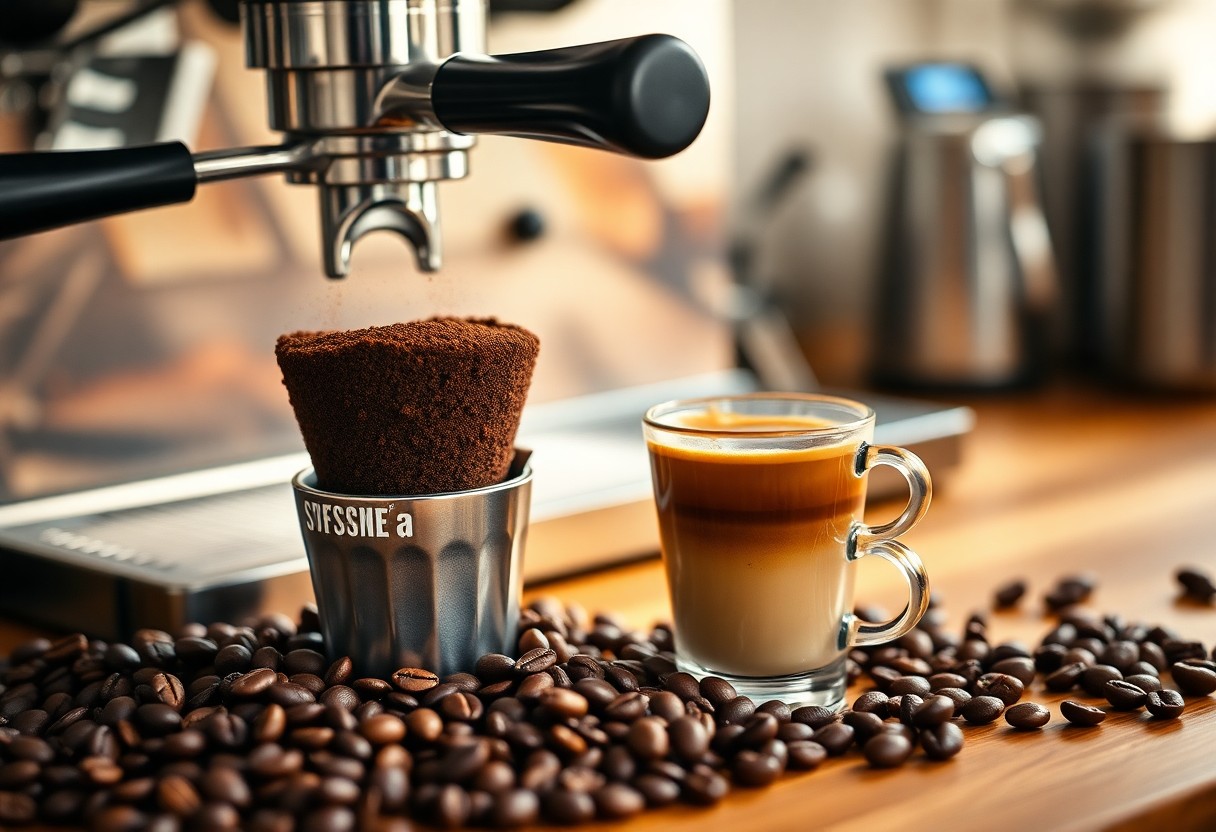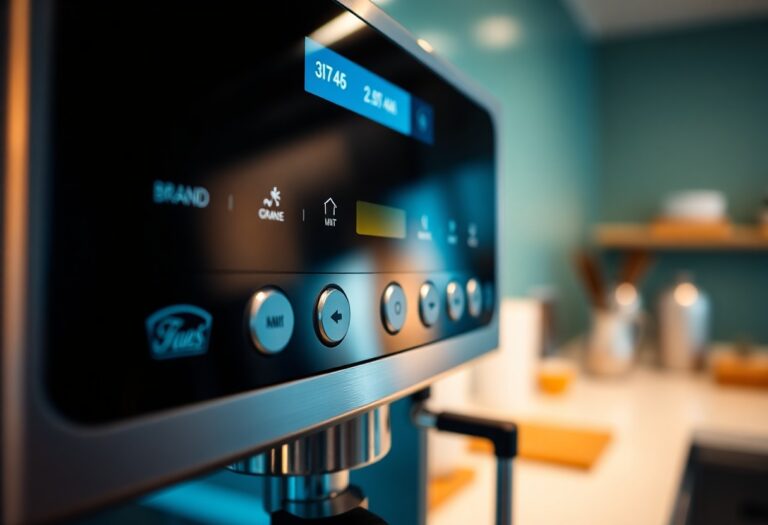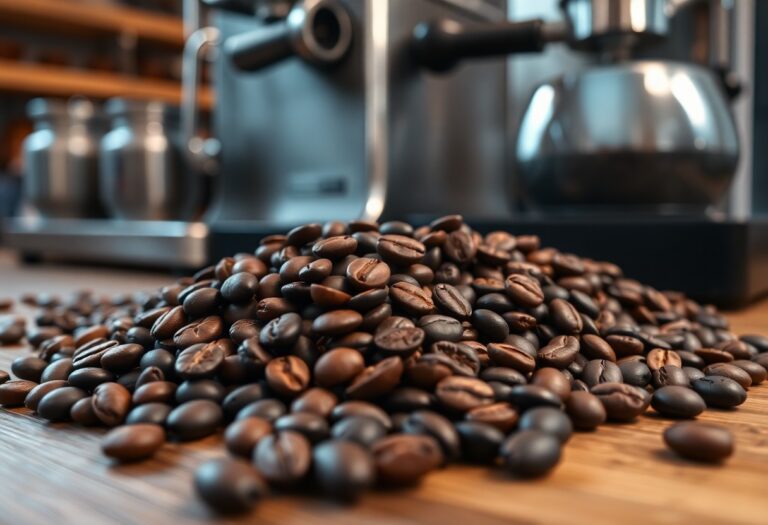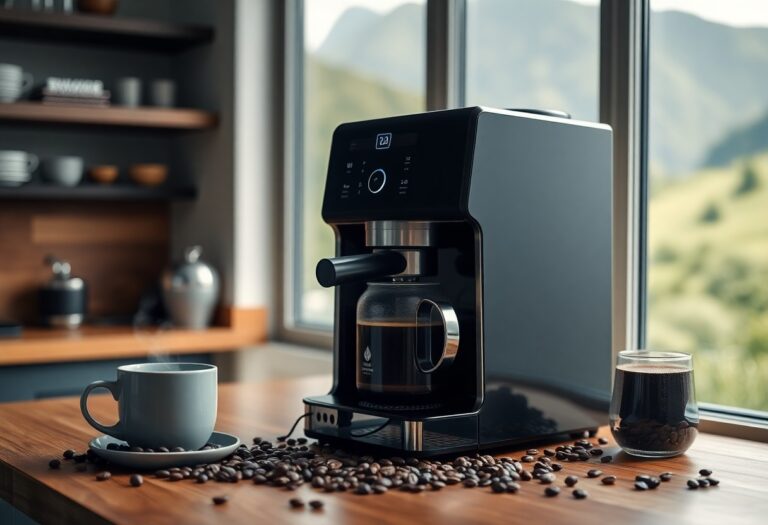What is a Portafilter on a Coffee Machine – Espresso Component
Coffee enthusiasts, you may be familiar with various components of your espresso machine, but understanding the importance of a portafilter is necessary for brewing great espresso. This component is what holds your coffee grounds during extraction, and it significantly influences the flavor and quality of your brew. A well-maintained portafilter ensures even extraction, allowing all the rich flavors of your coffee to shine through. For more insights, you can explore What’s the Difference Between a Portafilter and a Group Head?. Understanding its role can elevate your coffee-making experience.
Key Takeaways:
- A portafilter is a handheld tool used in espresso machines that holds the coffee grounds during the brewing process.
- It typically consists of a metal basket where the coffee is placed, and a handle for easy operation.
- Portafilters are available in various sizes and styles, with different baskets to accommodate different grind sizes and coffee doses.
- The quality and design of the portafilter can significantly affect espresso extraction and overall flavor.
- Regular cleaning and maintenance of the portafilter are imperative for maintaining the taste and quality of the espresso brewed.
The Anatomy of a Portafilter
Understanding the anatomy of a portafilter can enhance your espresso-making skills. This crucial component comprises several parts, each serving a specific purpose to ensure optimal extraction of flavors from your coffee grounds. By familiarizing yourself with these elements, you can make informed decisions when selecting or maintaining your portafilter, ultimately improving your espresso experience.
Key Components and their Functions
A portafilter typically consists of three main parts: the handle, the basket, and the spout. The handle provides a grip for you to lock and unlock the portafilter into the espresso machine. The basket holds the coffee grounds and is where the brewing magic happens; it comes in various sizes to accommodate different coffee amounts. Finally, the spout directs the brewed espresso into your cup, ensuring minimal mess during extraction.
Materials and Design Variations
Portafilters come in various materials and design variations, impacting both functionality and aesthetics. Common materials include stainless steel, brass, and aluminum, each offering unique benefits such as heat retention and durability. Designs also vary from single to double spouts, with aftermarket options providing customization to suit your brewing style.
Delving deeper into materials and design variations reveals a few insights. Stainless steel portafilters are favored for their resistance to corrosion and stable heat retention, while brass models excel in heat stability, perfect for consistent espresso shots. You may also find portafilters with pressure gauges or built-in screen filters, enhancing your extraction precision. As you explore these options, consider how each material and design can complement your brewing technique, as even small changes can yield a dramatically different espresso flavor profile.
The Role of the Portafilter in Espresso Extraction
The portafilter plays a pivotal role in espresso extraction, acting as the vessel that holds your coffee grounds while hot water passes through them. Proper placement of the portafilter ensures a smooth and consistent flow of water, allowing for optimal extraction of flavors. A well-functioning portafilter will create uniform pressure throughout, which helps achieve that rich, full-bodied espresso experience that coffee enthusiasts seek.
How It Influences Flavor and Aroma
Your choice of portafilter and its fittings directly affect the extraction process, influencing both the flavor and aroma of your espresso. The material and build quality can enhance heat retention, impacting how the water interacts with the coffee grounds. If the extraction is uniform, you’ll notice more balanced flavors and aromatic notes emerging in your cup, showcasing the true potential of your chosen beans.
Importance of Proper Grind and Dosing
Achieving the ideal grind size and correct dosing is foundational for using the portafilter effectively. Each coffee variety requires a specific grind for optimal extraction; too coarse or too fine can yield undesirable results. Dosing heavily influences the density of coffee grounds in the portafilter, directly correlating with the flavor extraction and overall quality of your espresso.
Setting the right grind size often involves calibrating your grinder to match your coffee type—espresso beans typically need a fine grind for the best extraction results. Similarly, dosing should be precise; using a scale to weigh your coffee is an excellent way to ensure consistency. The standard dosage for a double shot is usually between 18-20 grams. This attention to detail helps prevent channeling, which occurs when water flows unevenly through the grounds, leading to imbalanced flavors. By mastering these elements, you unlock the full potential of your espresso, enhancing your overall brewing experience.

Performance Factors and Maintenance Tips
To ensure your portafilter operates effectively, consider factors like grind size, tamping pressure, and extraction time. Regular maintenance is vital for optimal performance. Here are some tips to keep your portafilter in top shape:
- Clean after each use to prevent coffee oils from building up.
- Inspect the gasket for wear and replace it when necessary.
- Ensure your portafilter is securely locked during brewing for a proper seal.
- Use the right grind size for your coffee beans to avoid clogs and channeling.
Any issues with your portafilter can lead to subpar espresso results.
Common Issues with Portafilters
One common challenge you may face with portafilters is extraction inconsistencies due to uneven grind size or improper tamping technique. Clogs can also occur when coffee grounds accumulate in the filter basket or when the gasket becomes worn, causing leaks during extraction. Keeping an eye on these issues will help maintain a steady flow and flavor in your espresso.
Best Practices for Cleaning and Care
Cleaning your portafilter needs to be a regular part of your espresso routine. Rinse it with hot water after every use, and consider soaking it in a solution of cleaning detergent weekly. Regular checks for residue buildup help prevent clogs, while inspecting the filter basket ensures it remains clear and functional. Maintaining cleanliness not only prolongs the life of your portafilter but also enhances the overall taste of your coffee.
Taking care of your portafilter enhances both flavor and performance. After each use, rinse thoroughly with hot water and use a soft brush to dislodge any stubborn coffee grounds. Once a week, deep clean your portafilter with a specialty detergent designed for espresso machines to avoid oil accumulation. Pay attention to the basket and the spout, ensuring they are clear and free from blockages. Consistent cleaning routines not only benefit your equipment but also lead to a more delightful espresso experience.
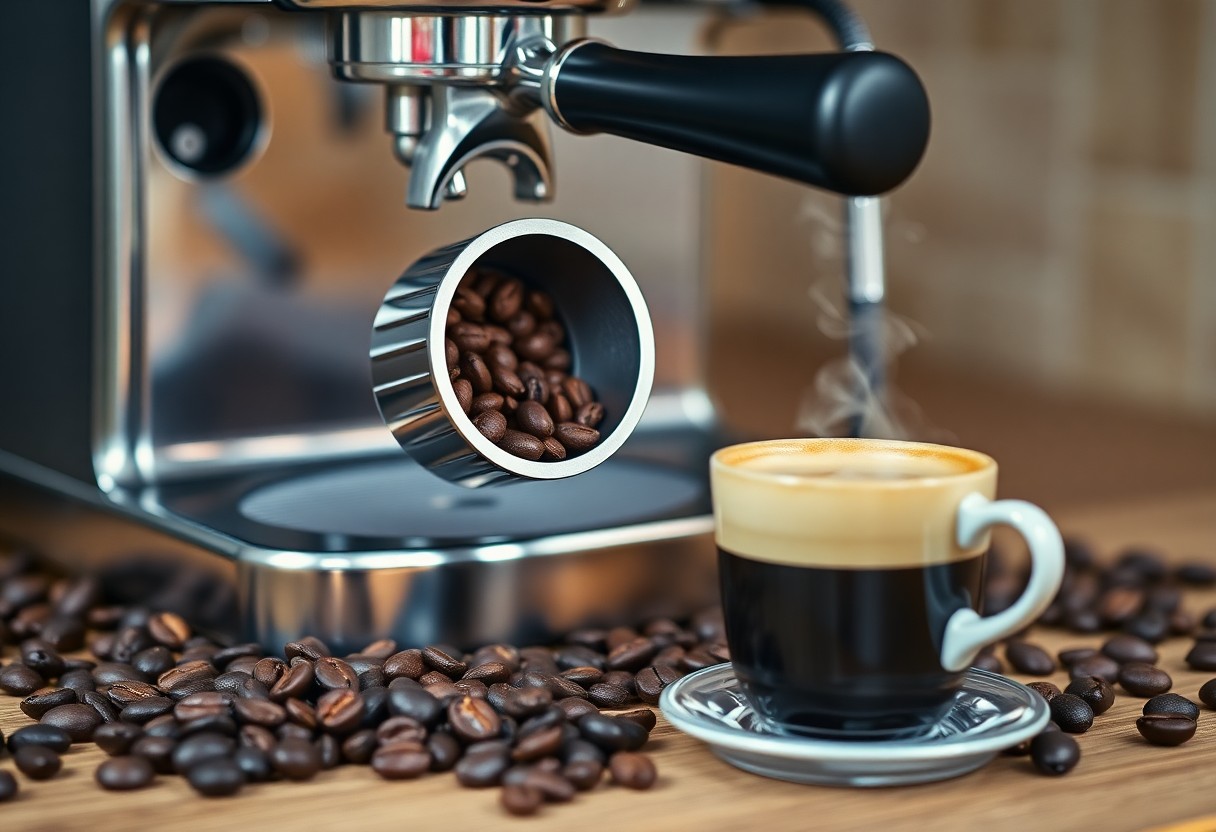
Transforming Your Espresso Experience: Expert Techniques
Elevating your espresso game involves mastering a few expert techniques that can significantly enhance your brewing experience. These methods will refine your approach to extraction, enable you to have better control over variables, and ultimately lead to a richer, more flavorful cup. Striving for perfection in each brew requires attention to detail and a willingness to experiment to discover what works best for your palate.
Techniques for Perfecting Extraction
Achieving optimal extraction means paying close attention to your grind size, dose, and tamping pressure. Start by calibrating your grinder to produce a fine consistency, crucial for proper extraction in the relatively short brewing time of espresso. Adjust your coffee dose to between 18-20 grams for a double shot, and apply consistent, even pressure while tamping to create a uniform coffee puck. These steps play a vital role in ensuring the water flows evenly through the coffee, yielding a balanced flavor profile.
Understanding Pressure and Temperature Control
Pressure and temperature play significant roles in the espresso extraction process, influencing the overall quality of your drink. Most espresso machines target an ideal brewing pressure of around 9 bars, ensuring that water filters through the coffee grounds at an optimal rate. Temperature settings typically range between 90°C and 96°C, affecting solubility and flavor extraction. Variations in either can alter your coffee’s taste, emphasizing the need for precise control throughout the brewing process.
Pressure vs. Temperature Control
| Factor | Optimal Setting |
|---|---|
| Pressure | 9 bars |
| Temperature | 90°C to 96°C |
Fine-tuning your pressure and temperature settings allows you to adjust extraction levels based on the coffee beans’ characteristics. For instance, lighter roasts may require a slightly higher temperature to unlock their full flavor, while a coarser grind can benefit from lower pressure to extract sweetness without bitterness. Experimenting with these variables provides an excellent opportunity to customize each espresso shot to your liking and brings out the unique characteristics of your chosen coffee.
Flavor Variability Based on Settings
| Variable | Impact on Flavor |
|---|---|
| Higher Pressure | Increased bitterness |
| Lower Temperature | Sourness |
Future Trends in Espresso Technology
As espresso technology evolves, you’ll witness exciting innovations that enhance both the brewing process and your coffee experience. The integration of advanced materials, improved temperature control, and even automation are reshaping how coffee enthusiasts approach espresso making. Emphasis on sustainability will continue to be a driving force, encouraging eco-friendly practices in machine design and component manufacturing.
Innovations in Portafilter Design
Modern portafilters are seeing significant advancements, including the introduction of innovative materials like lighter and more durable titanium and ergonomic designs that prioritize user comfort. Proprietary variations such as bottomless portafilters are gaining popularity, as they allow for better visual feedback during extraction. With redesigned shapes and sizes, your ability to fine-tune your grind and brew process is enhanced, optimizing flavor extraction like never before.
The Impact of Smart Technology on Espresso Making
Your espresso-making experience is becoming more intuitive, thanks to the rise of smart technology. Smart machines enable you to control temperature, pressure, and brew time via connected devices, providing you with real-time analytics and customized settings. This tech-savvy approach offers a perfect balance of *artistry* and *precision*, allowing both novices and seasoned baristas to attain exquisite results effortlessly.
Smart technology facilitates an unprecedented level of control in your espresso preparation. For instance, many machines now come with built-in sensors that monitor extraction variables, adjusting parameters on-the-fly to ensure optimal flavor. Through smartphone applications, you can customize brew profiles tailored to your specific taste preferences. Some advanced machines even employ machine learning to adapt to your brewing habits over time, continually refining your espresso experience. With these innovations, creating a perfect shot of espresso is no longer an art form reserved for professionals; you can achieve café-quality results right from your kitchen.
Final Words
As a reminder, the portafilter is an imperative component of your espresso machine, playing a key role in brewing quality coffee. It holds the coffee grounds and allows you to extract the rich flavors you’ve come to love. Understanding your portafilter’s design and how to use it effectively can greatly improve your espresso-making skills. Whether you’re a novice or an experienced barista, mastering this element will enhance your coffee experience and help you achieve that perfect cup every time.
FAQ
Q: What is a portafilter?
A: A portafilter is a handheld device used in espresso machines that holds the coffee grounds during brewing. It consists of a metal basket, a spout, and a handle, allowing for the easy insertion and removal from the espresso machine. The portafilter plays a key role in extracting the coffee and is necessary for producing a quality espresso shot.
Q: How does a portafilter work?
A: The portafilter works by holding the ground coffee under high pressure while hot water is forced through it during the brewing process. When the machine is turned on, water enters the portafilter, saturating the coffee grounds. The pressure builds up, and the water extracts flavors from the grounds, resulting in a rich and concentrated espresso shot.
Q: What are the different types of portafilters?
A: There are mainly two types of portafilters: single and double. A single portafilter holds enough grounds for a single espresso shot, while a double portafilter accommodates more grounds, typically allowing for two shots at once. Additionally, there are pressurized and non-pressurized baskets designed for different coffee grinding methods and skills.
Q: How do you clean and maintain a portafilter?
A: Cleaning a portafilter is necessary to maintain its performance and ensure the best flavor in your espresso. After each use, rinse the portafilter under hot water and scrub the basket with a brush to remove coffee residue. Periodically, perform a deep cleaning using a specialized espresso machine cleaner to remove any built-up oils and residues.
Q: Can a portafilter affect the taste of espresso?
A: Yes, a portafilter can significantly influence the taste of espresso. Factors such as the type of basket, the grind size, and the tamping pressure can all impact extraction. A well-maintained portafilter that fits snugly in the machine ensures the proper pressure and flow of water, leading to a more flavorful and balanced espresso shot.

